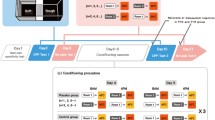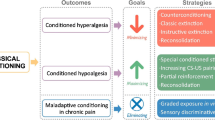Abstract
With the shifting role of placebos, there is a need to develop animal models of placebo analgesia and elucidate the mechanisms underlying the effect. In the present study, male Sprague-Dawley rats with chronic inflammatory pain caused by complete Freund’s adjuvant (CFA) underwent a series of conditioning procedures, in which morphine was associated with different cues, but they failed to induce placebo analgesia. Then, conditioning with the conditioned place preference apparatus successfully induced analgesic expectancy and placebo analgesia in naïve rats but only induced analgesic expectancy and no analgesic effect in CFA rats. Subsequently, we found enhanced c-fos expression in the nucleus accumbens and reduced expression in the anterior cingulate cortex in naïve rats while c-fos expression in the anterior cingulate cortex in CFA rats was not altered. In summary, the behavioral conditioning model demonstrated the difficulty of establishing a placebo analgesia model in rats with a pathological condition.







Similar content being viewed by others
References
Andrews P, Steultjens M, Riskowski J. Chronic widespread pain prevalence in the general population: a systematic review. Eur J Pain 2018, 22: 5–18.
Voon P, Karamouzian M, Kerr T. Chronic pain and opioid misuse: a review of reviews. Subst Abuse Treat Prev Policy 2017, 12: 36.
Duenas M, Ojeda B, Salazar A, Mico JA, Failde I. A review of chronic pain impact on patients, their social environment and the health care system. J Pain Res 2016, 9: 457–467.
Buchel C, Geuter S, Sprenger C, Eippert F. Placebo analgesia: a predictive coding perspective. Neuron 2014, 81: 1223–1239.
Klinger R, Colloca L, Bingel U, Flor H. Placebo analgesia: clinical applications. Pain 2014, 155: 1055–1058.
Tuttle AH, Tohyama S, Ramsay T, Kimmelman J, Schweinhardt P, Bennett GJ, et al. Increasing placebo responses over time in U.S. clinical trials of neuropathic pain. Pain 2015, 156: 2616–2626.
Petersen GL, Finnerup NB, Grosen K, Pilegaard HK, Tracey I, Benedetti F, et al. Expectations and positive emotional feelings accompany reductions in ongoing and evoked neuropathic pain following placebo interventions. Pain 2014, 155: 2687–2698.
Kaptchuk TJ, Friedlander E, Kelley JM, Sanchez MN, Kokkotou E, Singer JP, et al. Placebos without deception: a randomized controlled trial in irritable bowel syndrome. PLoS One 2010, 5: e15591.
Arakawa A, Kaneko M, Narukawa M. An investigation of factors contributing to higher levels of placebo response in clinical trials in neuropathic pain: a systematic review and meta-analysis. Clin Drug Investig 2015, 35: 67–81.
Enck P, Bingel U, Schedlowski M, Rief W. The placebo response in medicine: minimize, maximize or personalize? Nat Rev Drug Discov 2013, 12: 191–204.
Doering BK, Rief W. Utilizing placebo mechanisms for dose reduction in pharmacotherapy. Trends Pharmacol Sci 2012, 33: 165–172.
Benedetti F, Carlino E, Piedimonte A. Increasing uncertainty in CNS clinical trials: the role of placebo, nocebo, and Hawthorne effects. Lancet Neurol 2016, 15: 736–747.
Tracey I. Getting the pain you expect: mechanisms of placebo, nocebo and reappraisal effects in humans. Nat Med 2010, 16: 1277–1283.
Tetreault P, Mansour A, Vachon-Presseau E, Schnitzer TJ, Apkarian AV, Baliki MN. Brain connectivity predicts placebo response across chronic pain clinical trials. PLoS Biol 2016, 14: e1002570.
Benedetti F, Amanzio M, Thoen W. Disruption of opioid-induced placebo responses by activation of cholecystokinin type-2 receptors. Psychopharmacology (Berl) 2011, 213: 791–797.
Zubieta JK, Bueller JA, Jackson LR, Scott DJ, Xu Y, Koeppe RA, et al. Placebo effects mediated by endogenous opioid activity on mu-opioid receptors. J Neurosci 2005, 25: 7754–7762.
Dodd S, Dean OM, Vian J, Berk M. A review of the theoretical and biological understanding of the nocebo and placebo phenomena. Clin Ther 2017, 39: 469–476.
Klinger R, Flor H. Clinical and ethical implications of placebo effects: enhancing patients’ benefits from pain treatment. Handb Exp Pharmacol 2014, 225: 217–235.
Hrobjartsson A. What are the main methodological problems in the estimation of placebo effects? J Clin Epidemiol 2002, 55: 430–435.
Ben-Shaanan TL, Azulay-Debby H, Dubovik T, Starosvetsky E, Korin B, Schiller M, et al. Activation of the reward system boosts innate and adaptive immunity. Nat Med 2016, 22: 940–944.
Wendt L, Albring A, Schedlowski M. Learned placebo responses in neuroendocrine and immune functions. Handb Exp Pharmacol 2014, 225: 159–181.
Bryant CD, Roberts KW, Culbertson CS, Le A, Evans CJ, Fanselow MS. Pavlovian conditioning of multiple opioid-like responses in mice. Drug Alcohol Depend 2009, 103: 74–83.
Zhang RR, Zhang WC, Wang JY, Guo JY. The opioid placebo analgesia is mediated exclusively through mu-opioid receptor in rat. Int J Neuropsychopharmacol 2013, 16: 849–856.
Nolan TA, Price DD, Caudle RM, Murphy NP, Neubert JK. Placebo-induced analgesia in an operant pain model in rats. Pain 2012, 153: 2009–2016.
Guo JY, Yuan XY, Sui F, Zhang WC, Wang JY, Luo F, et al. Placebo analgesia affects the behavioral despair tests and hormonal secretions in mice. Psychopharmacology (Berl) 2011, 217: 83–90.
Guo JY, Wang JY, Luo F. Dissection of placebo analgesia in mice: the conditions for activation of opioid and non-opioid systems. J Psychopharmacol 2010, 24: 1561–1567.
Xu L, Wan Y, Ma L, Zheng J, Han B, Liu FY, et al. A context-based analgesia model in rats: involvement of prefrontal cortex. Neurosci Bull 2018, 34: 1047–1057.
McNabb CT, White MM, Harris AL, Fuchs PN. The elusive rat model of conditioned placebo analgesia. Pain 2014, 155: 2022–2032.
Lee IS, Lee B, Park HJ, Olausson H, Enck P, Chae Y. A new animal model of placebo analgesia: involvement of the dopaminergic system in reward learning. Sci Rep 2015, 5: 17140.
Bushnell MC, Ceko M, Low LA. Cognitive and emotional control of pain and its disruption in chronic pain. Nat Rev Neurosci 2013, 14: 502–511.
Wiech K. Deconstructing the sensation of pain: the influence of cognitive processes on pain perception. Science 2016, 354: 584–587.
Fiorio M, Recchia S, Corra F, Simonetto S, Garcia-Larrea L, Tinazzi M. Enhancing non-noxious perception: behavioural and neurophysiological correlates of a placebo-like manipulation. Neuroscience 2012, 217: 96–104.
Deuis JR, Dvorakova LS, Vetter I. Methods used to evaluate pain behaviors in rodents. Front Mol Neurosci 2017, 10: 284.
Benedetti F. Placebo responses in animals. Pain 2012, 153: 1983–1984.
Pecina M, Zubieta JK. Molecular mechanisms of placebo responses in humans. Mol Psychiatry 2015, 20: 416–423.
Gregory NS, Harris AL, Robinson CR, Dougherty PM, Fuchs PN, Sluka KA. An overview of animal models of pain: disease models and outcome measures. J Pain 2013, 14: 1255–1269.
Jaggi AS, Jain V, Singh N. Animal models of neuropathic pain. Fundamental & Clinical Pharmacology 2011, 25: 1–28.
Manchikanti L, Boswell MV, Kaye AD, Helm Ii S, Hirsch JA. Therapeutic role of placebo: evolution of a new paradigm in understanding research and clinical practice. Pain Physician 2017, 20: 363–386.
Watkins LR, Maier SF, Goehler LE. Immune activation: the role of pro-inflammatory cytokines in inflammation, illness responses and pathological pain states. Pain 1995, 63: 289–302.
Benedetti F, Amanzio M, Rosato R, Blanchard C. Nonopioid placebo analgesia is mediated by CB1 cannabinoid receptors. Na Med 2011, 17: 1228–1230.
Weimer K, Enck P. Traditional and innovative experimental and clinical trial designs and their advantages and pitfalls. Handb Exp Pharmacol 2014, 225: 237–272.
Rutherford BR, Mori S, Sneed JR, Pimontel MA, Roose SP. Contribution of spontaneous improvement to placebo response in depression: a meta-analytic review. J Psychiatr Res 2012, 46: 697–702.
Quessy SN, Rowbotham MC. Placebo response in neuropathic pain trials. Pain 2008, 138: 479–483.
He JH, Xu L, Shen Y, Kong MJ, Shi LY, Ma ZL. The changes of monocarboxylate transporter-2 in spinal cord horn in a rat model of chronic inflammatory pain. Zhongguo Ying Yong Sheng Li Xue Za Zhi 2015, 31: 19–22.
Miller FG, Kaptchuk TJ. The power of context: reconceptualizing the placebo effect. J R Soc Med 2008, 101: 222–225.
Allen JW, Yaksh TL. Assessment of acute thermal nociception in laboratory animals. Methods Mol Med 2004, 99: 11–23.
Lavich TR, Cordeiro RS, Silva PM, Martins MA. A novel hot-plate test sensitive to hyperalgesic stimuli and non-opioid analgesics. Braz J Med Biol Res 2005, 38: 445–451.
Mehalick ML, Ingram SL, Aicher SA, Morgan MM. Chronic inflammatory pain prevents tolerance to the antinociceptive effect of morphine microinjected into the ventrolateral periaqueductal gray of the rat. J Pain 2013, 14: 1601–1610.
Beaudry H, Gendron L, Moron JA. Implication of delta opioid receptor subtype 2 but not delta opioid receptor subtype 1 in the development of morphine analgesic tolerance in a rat model of chronic inflammatory pain. Eur J Neurosci 2015, 41: 901–907.
Bekhit MH. Opioid-induced hyperalgesia and tolerance. Am J Ther 2010, 17: 498–510.
Atlas LY, Wager TD. How expectations shape pain. Neurosci Lett 2012, 520: 140–148.
Schwarz KA, Pfister R, Buchel C. Rethinking explicit expectations: connecting placebos, social cognition, and contextual perception. Trends Cogn Sci 2016, 20: 469–480.
Carlino E, Benedetti F. Different contexts, different pains, different experiences. Neuroscience 2016, 338: 19–26.
Vase L, Norskov KN, Petersen GL, Price DD. Patients’ direct experiences as central elements of placebo analgesia. Philos Trans R Soc Lond B Biol Sci 2011, 366: 1913–1921.
Hall KT, Loscalzo J, Kaptchuk TJ. Genetics and the placebo effect: the placebome. Trends Mol Med 2015, 21: 285–294.
Colagiuri B, Schenk LA, Kessler MD, Dorsey SG, Colloca L. The placebo effect: From concepts to genes. Neuroscience 2015, 307: 171–190.
Colloca L, Grillon C. Understanding placebo and nocebo responses for pain management. Curr Pain Headache Rep 2014, 18: 419.
Qiu YH, Wu XY, Xu H, Sackett D. Neuroimaging study of placebo analgesia in humans. Neurosci Bull 2009, 25: 277–282.
Wager TD, Atlas LY. The neuroscience of placebo effects: connecting context, learning and health. Nat Rev Neurosci 2015, 16: 403–418.
Faria V, Fredrikson M, Furmark T. Imaging the placebo response: a neurofunctional review. Eur Neuropsychopharmacol 2008, 18: 473–485.
de la Fuente-Fernandez R, Schulzer M, Stoessl AJ. Placebo mechanisms and reward circuitry: clues from Parkinson’s disease. Biol Psychiatry 2004, 56: 67–71.
Bush G, Luu P, Posner MI. Cognitive and emotional influences in anterior cingulate cortex. Trends Cogn Sci 2000, 4: 215–222.
Bush G, Vogt BA, Holmes J, Dale AM, Greve D, Jenike MA, et al. Dorsal anterior cingulate cortex: a role in reward-based decision making. Proc Natl Acad Sci U S A 2002, 99: 523–528.
Devinsky O, Morrell MJ, Vogt BA. Contributions of anterior cingulate cortex to behaviour. Brain 1995, 118: 279–306.
Stuber GD, Sparta DR, Stamatakis AM, van Leeuwen WA, Hardjoprajitno JE, Cho S, et al. Excitatory transmission from the amygdala to nucleus accumbens facilitates reward seeking. Nature 2011, 475: 377–380.
Baliki MN, Geha PY, Fields HL, Apkarian AV. Predicting value of pain and analgesia: nucleus accumbens response to noxious stimuli changes in the presence of chronic pain. Neuron 2010, 66: 149–160.
Linde K, Fassler M, Meissner K. Placebo interventions, placebo effects and clinical practice. Philos Trans R Soc Lond B Biol Sci 2011, 366: 1905–1912.
Kabadi R, Kouya F, Cohen HW, Banik RK. Spontaneous pain-like behaviors are more sensitive to morphine and buprenorphine than mechanically evoked behaviors in a rat model of acute postoperative pain. Anesth Analg 2015, 120: 472–478.
Tappe-Theodor A, Kuner R. Studying ongoing and spontaneous pain in rodents–challenges and opportunities. Eur J Neurosci 2014, 39: 1881–1890.
Acknowledgements
This work was supported by grants from the National Natural Science Foundation of China (31720103908, 31530028, and 81821092) and the National Basic Research Development Program of the Ministry of Science and Technology of China (2017YFA0701300).
Author information
Authors and Affiliations
Corresponding author
Ethics declarations
Conflict of interest
The authors declare no conflict of interest.
Electronic supplementary material
Below is the link to the electronic supplementary material.
Rights and permissions
About this article
Cite this article
Yin, XS., Yang, JY., Cao, S. et al. Failure of Placebo Analgesia Model in Rats with Inflammatory Pain. Neurosci. Bull. 36, 121–133 (2020). https://doi.org/10.1007/s12264-019-00420-6
Received:
Accepted:
Published:
Issue Date:
DOI: https://doi.org/10.1007/s12264-019-00420-6




